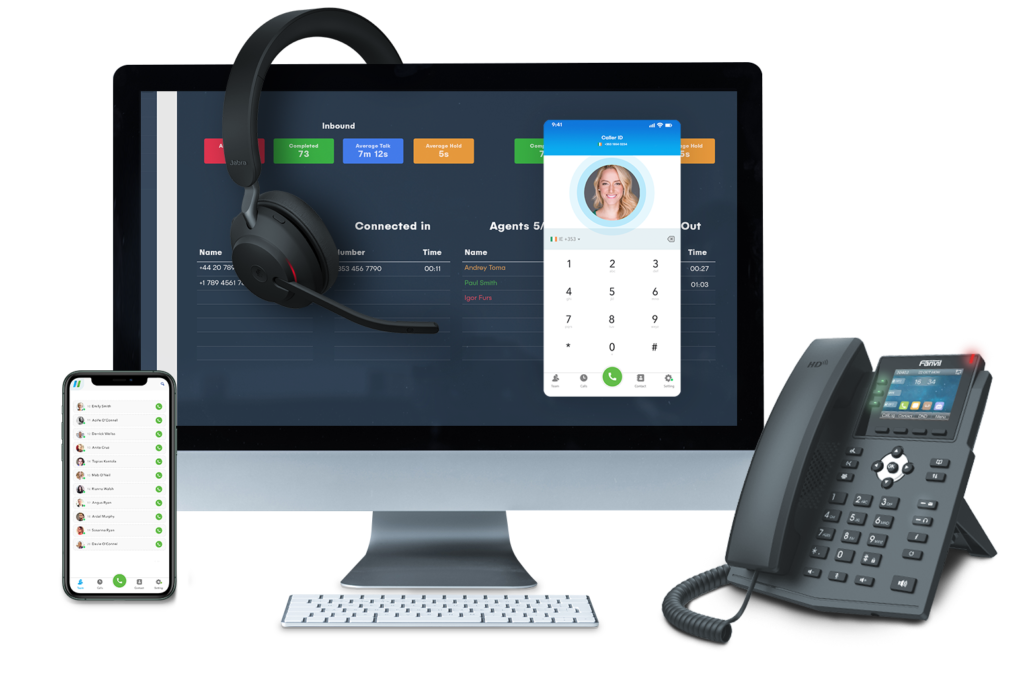Analog and VoIP are two popular switchboard systems today. Each system has its own characteristics. Therefore, in the article below, let’s compare Analog and VoIP switchboards with ITY to see the advantages and disadvantages of each switchboard and make the most suitable choice.
1. What is VoIP switchboard?
VoIP or IP switchboard is a switchboard system that is connected and operates on the internet platform, using LAN, WAN or Internet to make outgoing calls. Thanks to the application of modern technology, IP switchboards increasingly possess many superior features, and have gradually become an effective customer care support solution for businesses to replace traditional switchboards.

2. What is Analog switchboard?
Analog switchboard or landline is a switchboard system that has been around for a long time, operating through postal lines. When using this switchboard, switchboard providers will pull the line to the office – where the switchboard of the business is located.

3. Differences between traditional Analog switchboard and VoIP virtual switchboard
Analog PBX and VoIP virtual PBX are two different communication systems with different technologies and features. Here are the main differences between the two types of PBX:
About Transmission Technology
Analog PBX uses audio transmission technology through the traditional PSTN (Public Switched Telephone Network), while VoIP virtual PBX uses VoIP (Voice over Internet Protocol) technology to transmit voice over the internet.
About Infrastructure
Analog PBX requires physical infrastructure with traditional copper telephone lines and switching centers, while VoIP virtual PBX is a software-based system that does not require complex physical structures.
Telephone equipment using switchboard
Analog PBX: Requires the use of traditional telephone equipment such as landline telephones or cordless phones that are directly connected to the PBX. Telephone equipment using Analog PBX usually has basic features such as calling, call forwarding and call holding.
VoIP Virtual PBX: Telephone devices that use VoIP virtual PBX can be VoIP phones or smartphones with VoIP applications installed. These devices connect to the PBX system via the internet and provide many advanced features such as video calling, phone conferencing, call recording and integration with other applications.

Switchboard performance
Analog PBX: The performance of an analog PBX can be limited by physical factors and transmission technology. Analog PBXs require physical infrastructure and use the traditional PSTN telephone network. This can affect the reliability and scalability of the system.
VoIP PBX: The performance of a VoIP PBX is often higher. With VoIP technology, the PBX system is able to transmit voice over the internet, minimizing geographical restrictions and increasing flexibility. VoIP PBXs are also often more available and have backup capabilities to ensure continuous operation.
Costs that businesses have to pay
VoIP PBXs typically have lower initial configuration costs than analog PBXs. This is due to the use of software and internet connectivity, which reduces the need for physical equipment and configuration.
In terms of call costs, VoIP PBXs typically have lower call costs than analog PBXs. By using the internet to transmit voice, VoIP PBX calls can be cost-effective, especially when calling internationally or long distances.
At the same time, VoIP PBXs also offer more flexibility and advanced features than analog PBXs. With features such as direct calling from a web browser, mobile applications, and unlimited extension expansion, VoIP PBXs offer greater convenience and interoperability.
In terms of management and scalability, VoIP PBXs are typically easy to manage and configure from an intuitive web interface. Adding new extensions and features, managing calls and monitoring performance also becomes easier, much more cost-effective than traditional Analog switchboards.
Flexibility and mobility
Analog PBXs are limited in flexibility and mobility, as they require a fixed infrastructure and cannot be moved easily. Meanwhile, VoIP virtual PBXs are highly flexible and can be accessed from anywhere with an internet connection, allowing users to work remotely and move around easily.

Features and integrations
VoIP PBXs typically offer advanced features like call forwarding, recording, phone conferencing, and integration with other applications like CRM. Analog PBXs, on the other hand, are limited in features and integrations.
Manage and expand
VoIP virtual switchboard allows easier and more flexible management. Users can manage and configure the system from an intuitive web interface, quickly change settings, add new extensions and features. Meanwhile, Analog switchboard requires physical intervention and complex installation work for expansion and change.
Availability and reliability
VoIP PBXs typically offer higher availability and better reliability than analog PBXs. With software-based architecture and backup capabilities, VoIP PBXs can automatically switch operations between different data centers in the event of a failure, keeping the service up and running.
International and multicultural
VoIP virtual switchboards offer the ability to connect internationally easily and efficiently. With VoIP, international calls can be made at lower rates and without geographical restrictions. This is very useful for organizations that conduct international business and have to communicate with customers and partners in many different countries.
4. Should businesses use Analog or VoIP switchboard?
Through the comparison of IP switchboard and Analog switchboard in the above section, it can be seen that IP switchboard has many outstanding advantages over Analog switchboard. These advantages meet most of the needs of businesses. From no cost, easy to upgrade, expand, manage to diverse features, flexibility in use…
These advantages have helped IP switchboard increasingly surpass traditional Analog switchboard. That is why IP switchboard has become a customer care support solution chosen by many businesses, helping businesses improve professionalism and work efficiency.
YCall Switchboard – Professional and cost-effective switchboard solution
- Package cost: No need to invest in switchboard hardware, save up to 50% on phone costs
- Recording, Statistics and reports: Automatically record all calls, detailed reports help evaluate employee performance.
- Multi-platform support: Most people have Customers can use terminals on computers and smartphones.
- Switchboard supports all prefixes: ITY supports all prefixes so customers can rest assured when calling. No need to worry about number blocking causing interruptions to sales calls anymore.
Start your business switchboard and try it for free now!
Contact the following information for more detailed advice:
Hotline: 1900 099985




